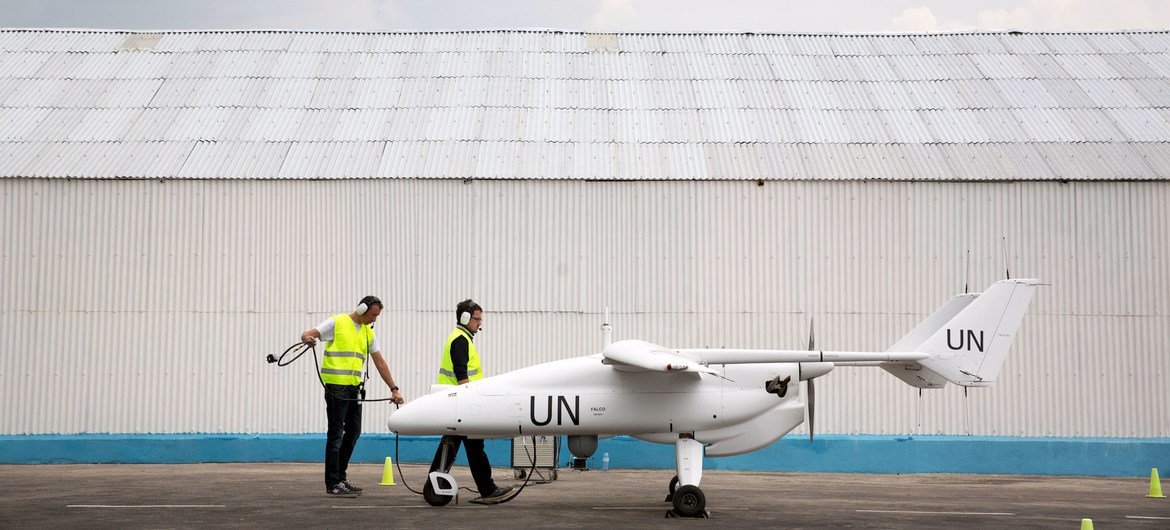“Our thinking should be grounded by the fact that we have more conflicts today than at any time since World War Two and by the evolving nature of conflict,” said Catherine Pollard, UN Under-Secretary-General for Management Strategy, Policy and Compliance, in her opening remarks to the two-day meeting held 4 and 5 February.
An unmanned aerial vehicle or drone is prepared for flight in Goma, in the Democratic Republic of the Congo. (file)
‘Blue Helmets’ need 21st century tools
Delegates offered up some recommendations to give UN peacekeepers better tools they need to face multiple challenges.
These include the use of unmanned aerial vehicles (UAVs) by peacekeepers for situational awareness and self-defence, streamlined decision-making mechanisms, more informal briefings to the Security Council and strengthened training in urban warfare.
In preparation for a ministerial meeting on UN peacekeeping in Germany in May, civilian, military and police experts came together at the Peacekeeping Training Centre of the Indonesian Armed Forces to help deliver on the vision of the UN Secretary-General to make peacekeeping “fit for the needs of the 21st century”.
Today’s challenges require adapting the UN’s approach to peacekeeping and the way peacekeeping operations are put in place, panelists said.
Defensive drones
Such adaptation includes authorizing the use of new technologies some of which are already used by adversaries, such as UAVs that carry weapons.
Colonel Ismael Andrés, Deputy Director of Uruguay’s National System of Peacekeeping Operations, recalled that major UN missions operating today were initially authorised to only use UAVs for surveillance and intelligence gathering. That must change, her argued.
“We need to get Security Council authorisation for the use of drones for self-defence as well,” he added, emphasising new threats to peacekeeping linked to UAVs.
Shamala Kandiah Thompson, executive director of Security Council Report, an independent think tank, said regular briefings to the Security Council on the challenges faced by operational missions and the availability of peacekeeping models – a sort of menu of options to fit different situations – could speed up decision making and make peacekeeping more effective.
“There are undoubtedly geopolitical tensions that influence decision making in the Security Council, but more informal briefings and engagement could help the Council response better to realities on the ground,” she said.
Cost-effective solutions
The UN’s peacekeeping missions combine unique capabilities and capacities honed through decades of lessons learned from UN operations around the globe.
Over their long history, UN peacekeeping missions have created space for political dialogue between parties to a conflict, facilitated and acted as guarantors of peace agreements, fostered regional stability by containing the spread of violence, protected civilians, built sustainable institutions of rule of law and worked with host countries to help rebuild governance structures.
“Many studies have shown that UN peacekeeping is a very cost-effective tool to stop armed conflicts and maintain peace, particularly when complex, multidimensional missions are involved,” said El-Ghassim Wane, lead author of a study on the future of peacekeeping, commissioned by the UN Department of Peace Operations.
“As a case in point, see what happened in countries like Haiti and Sudan after the pull out of UN peacekeeping forces.”
Sharing ideas and adapting new models
The global forum, co-hosted by the governments of Bangladesh, Indonesia, the Netherlands and the United States, aimed to bring together Member States and other stakeholders in advance of the ministerial meeting in Germany to share ideas and propose courses of action for adapting new models, structures, processes and responsibilities.
The gathering also aimed to identify resources and Member State capabilities to ensure that UN peacekeeping can respond to evolving multidimensional challenges and remain fit for purpose.





























